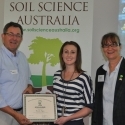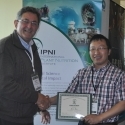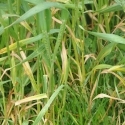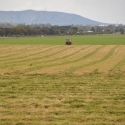17 Apr 2012
IPNI ANZ Regional Program Strategies
Rob Norton, Regional Director, IPNI ANZ
This summary provides a framework for discussion of the work of IPNI in the ANZ at the first PAC meeting, indicating regional issues and responses. A key underpinning strategy of all IPNI activities is the promotion on the 4R’s nutrient stewardship principles to all sectors of the industry.
1. New markets for fertilizers in Australia:
· Cotton + 17%, rice +28%, canola now 3 largest crop, +14% 2010 to 2011, 2012 looks favorable.
Response - Cotton research on K, P and S with QDPI (member company involvement).
· Specialized nutrients for canola – high sulfur demand relative to wheat.
Response – Improved S (N & P) nutrition, sulfur supplements research, S source comparisons, balancing N, P and S nutrition. Publications on S.
· K may be a significant untreated deficiency.
o Declining K usage in Australia – 2010 use down 23% on average of previous 10 years. NZ big recovery in 2010.
o Total K balance for Australia is 3.3 times the current K use of 113 kt K. WA (31%), Queensland (35%) and Victoria (20%) make up the majority of this market.
o Soil tests less than 120 kg K/ha - 14% NSW, 24% Victoria, 29% SA, 60% Queensland.
Response – K placement and rate experiments in Queensland grain cropping areas with QAAFI.
· Trace element nutrition (Cu, Zn, Mn, B, Mo) has been widely promoted with little substantive information on best management strategies.
Response - Articles, advisor talks and website initiative on evidenced based agriculture – growers demanding the science behind the recommendations. Scoping study to identify potentially responsive areas by region, soil type, season, history and crop (GRDC, following IPNI initial study).
· Livestock and pasture nutrition - With fairly rapid growth in livestock numbers, and a greater reliance on livestock for cash flow / profit on mixed farms.
Response - re-education process required on pasture legume nutrition i.e. P, S, Mo, Rhizobia and the possible interactions of trace elements in livestock, similar to workshops held in March 2011. Support MLA investments on improved P management.
· Uncertain role for other nutrients such as silicon and magnesium.
Response – opportunity for future research programs to scope and then use the 4R platform to develop best management practice. Identify key local and international researchers.
2. Embedding the 4R nutrient stewardship approach for improved production, environmental and social outcomes:
· Global Initiatives about supply chain impacts (e.g. Sustainability Consortium; Sustainable Agriculture Initiative; Keystone Alliance for Sustainable Agriculture), footprinting (Water, Carbon, Nitrogen and Phosphorus and nutrient impacts (e.g. International Nitrogen Initiative, Global Phosphate Research Initiative, Global TraPs).
Response – IPNI engagement in the discussions nationally and internationally and collaboration with FIFA, IFA and the science community.
· Carbon Trading – N management within a carbon trading system and reducing N2O losses.
· Water Quality – 19/50 catchments with major N exceedance, 40/75 with major P exceedance resulting in nutrient management programs (legislated/supported/encouraged)
o Current interventions - Reef Rescue, Peel-Harvey Estuarine Systems, Lake Taupo NZ.
o Likely future interventions - Gippsland Lakes, Tasmania, Lake Connewarre / Barwon estuary, peri-urban horticultural areas e.g. Mornington Peninsula, Cumberland Plain
Responses – work with researchers and government on the science to link nutrient best management practices to environmental outcomes; 4R strategies to improve nutrient efficiency; Regional nutrient balance data (update 1996 data)linking to nutrient hotspots website initiative and publications for 2012 (including International 4R Plant Nutrition Manual); New Dairy Australia project – “National Guidelines for Managing Nutrient Efficiency and Soil Acidity”. Promotion of 4R’s Nutrient stewardship across the industry.
· Fertilizer P contaminants require continual monitoring.
Response – develop strategies with peak fertilizer industry body (FIFA) and leading scientists to develop strategies to address these issues. Analysis at long term fertilizer sites.
3. Increase grower and advisor confidence in using nutrients profitably (4R’s)
· Only 22% of Australian landholders use soil tests with the highest take up in Tasmania (68%) and Western Australia (31%). This is a poor uptake rate in the eastern states of what would be seen as an essential technology for fertilizer application and a key in the 4R’s.
Response – Publish long term soil test trends, encourage soil testing, participate in the GRDC Better Fertilizer Decisions for Crops project, publication of best management guides, data from long term experiments. Better soil tests (eg QDPI project). Assist with development of better soil tests such as the DGT-P test for calcareous soils.
· Maintain long term experiments showing the responses of crops and pastures to applied nutrients.
Response – Involvement in the Dahlen long term fertilizer experiment; publication and interpretation of the results. Demonstrates the importance of matching N and P rates in a 4R framework.
· Calibration curves for fertilizer soil tests are important, as is providing growers and advisors access to local information on appropriate crops.
Response – Participation in GRDC project “Making better fertilizer decisions for cropping systems in Australia”. This participation will continue in the $7.5 M, 5 year investment by GRDC to commence in July 2012.
· Provision of independent nutrient management guidelines to growers and advisors.
Response - Develop and promote nutrient best management practices based on the global 4R’s nutrient stewardship principles. Wheat N & P completed, 4R’s canola guide being developed. Frameworks using the 4R’s based on the science of nutrient application and advanced fertilizer technology.
· Avoiding crop damage with fertilizers applied in furrow.
Response – development and distribution of “Spreadsheet guide to fertilizer toxicity” – consider re-designing as a webtool and an “app”.
4. Science vacuum and member company support
· Emphasis on the importance of evidence in the assessment of issues relating the nutrient management.
Response – Maintain an active scientific publication record and attendance at appropriate scientific meetings. Production of articles for press and member company publications. Speaking at appropriate industry meetings and presenting seminar and training programs for member companies. Link to international research and development programs to bring in new ideas and strategies (e.g. Crawford Fund project with Africa).




